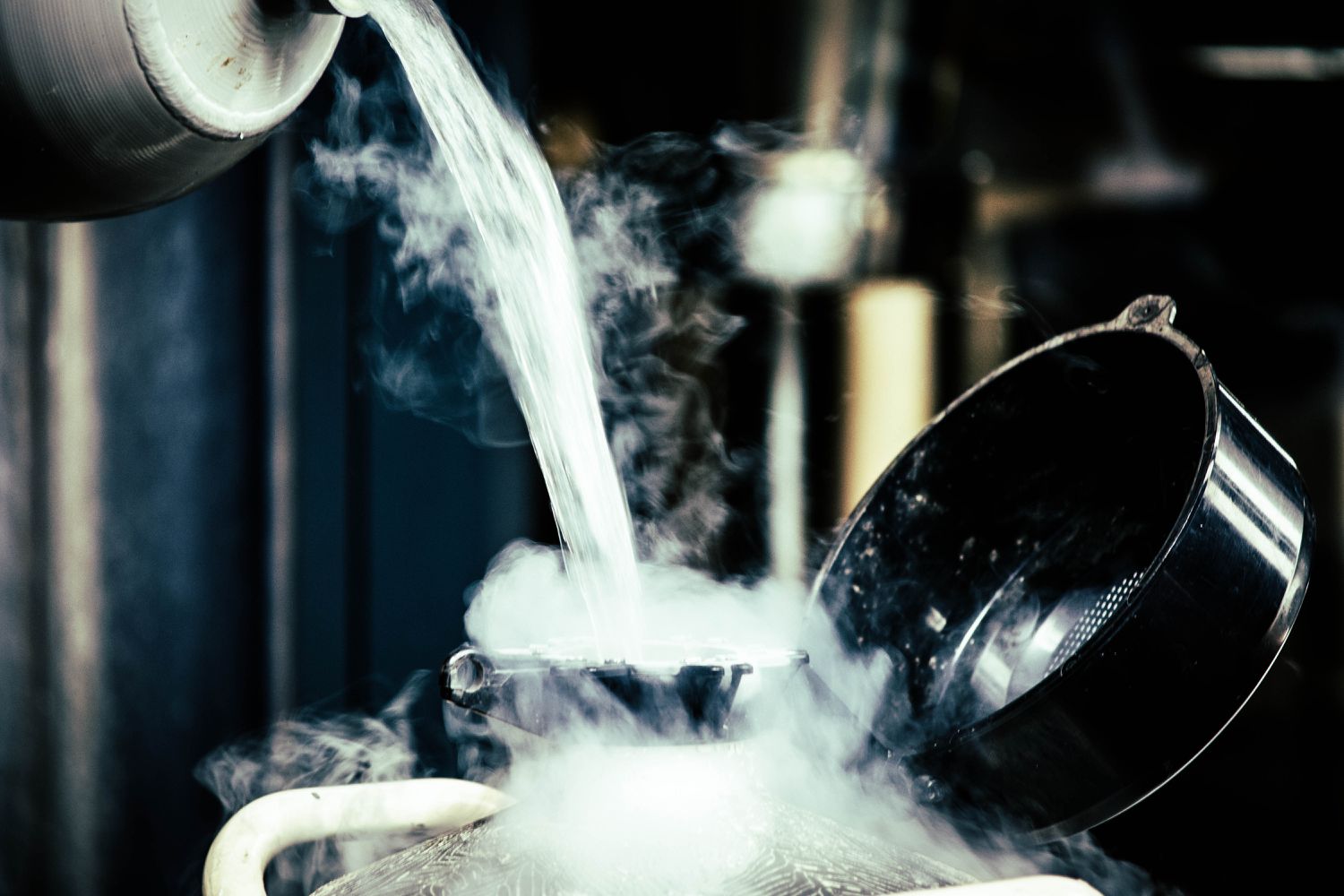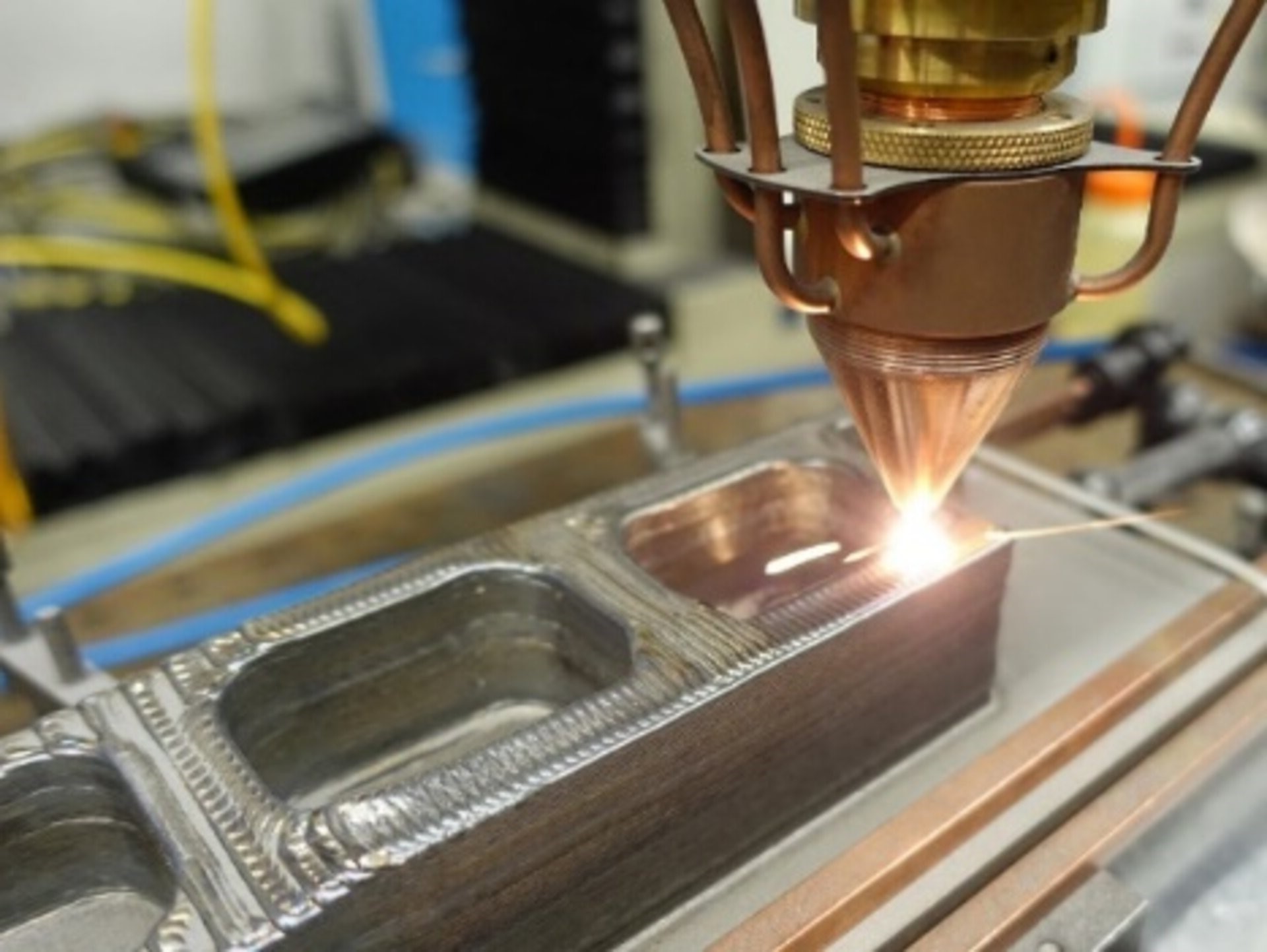Home>Science & Environment>The Temperature Of Liquid Nitrogen


Science & Environment
The Temperature Of Liquid Nitrogen
Published: February 19, 2024
Learn about the science and environmental impact of liquid nitrogen's temperature. Explore its uses and effects on the environment. Gain insights into the significance of this scientific phenomenon.
(Many of the links in this article redirect to a specific reviewed product. Your purchase of these products through affiliate links helps to generate commission for Temperatures.com, at no extra cost. Learn more)
Table of Contents
Introduction
Liquid nitrogen is a fascinating substance that has captivated the imagination of scientists and the general public alike. With its incredibly low temperature and diverse applications, liquid nitrogen plays a crucial role in various fields, from scientific research to culinary arts. Understanding the properties, uses, and safety considerations associated with liquid nitrogen is essential for anyone working with or simply curious about this remarkable substance.
The unique properties of liquid nitrogen stem from its composition as a colorless, odorless, and tasteless diatomic gas at standard conditions. When cooled to its boiling point of -196 degrees Celsius (-321 degrees Fahrenheit), it transforms into a liquid state, revealing its remarkable characteristic as one of the coldest substances on Earth. This extreme coldness makes liquid nitrogen a valuable tool in a wide range of applications, from cryogenic preservation to industrial processes.
As we delve into the world of liquid nitrogen, we will explore its properties, uses, and safety precautions. By gaining a deeper understanding of this extraordinary substance, we can appreciate its significance in scientific research, medical treatments, and everyday applications. Let's embark on a journey to uncover the wonders of liquid nitrogen and its impact on various aspects of our lives.
Properties of Liquid Nitrogen
Liquid nitrogen, a cryogenic fluid, possesses several remarkable properties that make it invaluable in a wide array of applications. Understanding these properties is crucial for utilizing liquid nitrogen safely and effectively.
1. Boiling Point:
Liquid nitrogen has an exceptionally low boiling point of -196 degrees Celsius (-321 degrees Fahrenheit). This extreme coldness allows it to rapidly vaporize when exposed to ambient temperatures, creating a visually striking effect often used in demonstrations and experiments.
2. Colorless and Odorless:
In its liquid state, nitrogen is transparent and lacks any discernible odor. This characteristic makes it challenging to detect leaks or spills, emphasizing the importance of handling liquid nitrogen with caution and in well-ventilated areas.
3. Non-Flammable:
Unlike many other common fluids, liquid nitrogen is non-flammable, making it a safer option for certain applications where flammability is a concern. This property enhances its utility in various industrial processes and scientific experiments.
4. Extreme Coldness:
At its boiling point, liquid nitrogen exhibits an astonishingly low temperature. This extreme coldness enables it to rapidly freeze and preserve biological samples, making it an indispensable tool in cryopreservation and medical research.
5. Expansion Ratio:
When liquid nitrogen vaporizes into its gaseous state, it expands dramatically. This expansion ratio is approximately 1:694, meaning that one volume of liquid nitrogen yields 694 volumes of gaseous nitrogen. This unique property is harnessed in various engineering and industrial applications.
6. Thermal Conductivity:
Liquid nitrogen has high thermal conductivity, allowing it to rapidly transfer its low temperature to objects it comes into contact with. This property is leveraged in cryogenic cooling systems and processes that require precise temperature control.
7. Density:
The density of liquid nitrogen is approximately 0.808 g/cm³, making it significantly lighter than water. This characteristic influences its behavior in various settings, such as its ability to displace air and create an oxygen-deficient environment if not handled properly.
Understanding these properties of liquid nitrogen is essential for utilizing it effectively while prioritizing safety. Whether in scientific research, industrial applications, or medical treatments, the unique characteristics of liquid nitrogen continue to shape and enhance diverse fields, showcasing its significance as a versatile and impactful substance.
Read more: Average Temperature In Atlanta
Uses of Liquid Nitrogen
Liquid nitrogen's exceptional properties make it indispensable across various industries and scientific disciplines. Its versatility and extreme coldness enable a wide range of applications, showcasing its significance in shaping modern technologies and processes.
Cryopreservation and Biological Research
One of the most prominent uses of liquid nitrogen is in cryopreservation, where biological samples, including cells, tissues, and reproductive materials, are preserved at ultra-low temperatures. This process allows for long-term storage of biological specimens, facilitating medical research, organ transplantation, and the conservation of genetic diversity in agriculture.
Food and Beverage Industry
In the culinary world, liquid nitrogen is employed for flash freezing and creating unique textures in dishes. Its rapid freezing capabilities are utilized to produce innovative frozen desserts, such as ice creams and sorbets, as well as to enhance the presentation of various culinary creations. Additionally, liquid nitrogen is used in the production of frozen food products, ensuring the preservation of quality and freshness.
Medical Treatments and Dermatology
In dermatology and medical treatments, liquid nitrogen is utilized for cryotherapy, a procedure that involves applying extreme cold to treat skin conditions, warts, and precancerous lesions. The rapid freezing action of liquid nitrogen is instrumental in destroying abnormal tissues and promoting the regeneration of healthy skin cells, making it a valuable tool in medical practices.
Read more: Understanding The Temperature Of Venus
Industrial Applications
Liquid nitrogen finds extensive use in industrial settings, where its low temperature and non-reactive nature are leveraged for various purposes. It is employed in cryogenic grinding to process heat-sensitive materials, such as spices and pharmaceuticals, without compromising their properties. Additionally, liquid nitrogen is utilized in the manufacturing of electronics, metal processing, and as a coolant in industrial machinery and processes.
Scientific Research and Laboratory Applications
In scientific research, liquid nitrogen serves as a critical component in laboratories worldwide. It is used for cooling and preserving biological samples, conducting experiments in physics and chemistry, and maintaining the functionality of superconducting materials. Furthermore, liquid nitrogen is essential for creating ultra-low temperature environments required for certain scientific investigations and material testing.
Cryogenic Cooling and Superconductivity
Liquid nitrogen plays a pivotal role in cryogenic cooling systems, particularly in superconducting applications. It is used to cool superconducting magnets in MRI machines, particle accelerators, and other scientific instruments, enabling the efficient generation of powerful magnetic fields and the advancement of research in physics and materials science.
Environmental and Agricultural Applications
In environmental and agricultural contexts, liquid nitrogen is utilized for soil freezing to facilitate excavation and construction projects. It is also employed in controlled atmosphere storage to preserve fruits, vegetables, and seeds, extending their shelf life and maintaining their nutritional quality.
The diverse and impactful uses of liquid nitrogen underscore its significance in modern society, driving innovation and progress across multiple fields. From preserving biological materials to enhancing culinary experiences and advancing scientific research, liquid nitrogen continues to shape and enrich various aspects of our lives, exemplifying its indispensable role in contemporary technologies and applications.
Read more: Monthly Temperature Guide for Banff
Safety Precautions when Handling Liquid Nitrogen
When working with liquid nitrogen, it is paramount to prioritize safety to mitigate potential risks associated with its extreme cold temperature and rapid vaporization. Implementing comprehensive safety precautions is essential to ensure the well-being of individuals and the integrity of equipment and facilities.
-
Personal Protective Equipment (PPE): Proper attire, including insulated gloves, face shields, and closed-toe shoes, should be worn when handling liquid nitrogen to protect against cold burns and potential exposure to splashes or spills.
-
Ventilation: Utilize liquid nitrogen in well-ventilated areas to prevent the accumulation of nitrogen gas, which can displace oxygen and lead to asphyxiation in confined spaces.
-
Storage and Handling: Store liquid nitrogen in well-designed, vented containers specifically intended for cryogenic fluids. When transporting or transferring liquid nitrogen, use appropriate equipment and follow established protocols to minimize the risk of spills and exposure.
-
Avoid Sealed Containers: Never seal liquid nitrogen in airtight or pressure-resistant containers, as the rapid vaporization of nitrogen gas can cause a dangerous buildup of pressure, potentially leading to container rupture or explosion.
-
Training and Awareness: Ensure that personnel handling liquid nitrogen are adequately trained in its safe use and are aware of the potential hazards and proper emergency response procedures.
-
Preventing Frostbite: Exercise caution to prevent direct contact between skin and liquid nitrogen, as it can cause severe frostbite upon contact due to its extremely low temperature.
-
Emergency Response: Establish clear protocols for responding to spills, leaks, or exposure incidents, including the availability of emergency eyewash stations and showers in areas where liquid nitrogen is used.
-
Labeling and Signage: Clearly label containers and areas where liquid nitrogen is stored or used, and display appropriate signage to communicate potential hazards and safety precautions.
By adhering to these safety precautions and promoting a culture of awareness and responsibility, the risks associated with handling liquid nitrogen can be effectively minimized, ensuring a safe working environment for all individuals involved.
The implementation of these safety measures is crucial in various settings, including research laboratories, industrial facilities, and medical institutions, where the use of liquid nitrogen is prevalent. Prioritizing safety not only safeguards personnel and facilities but also contributes to the responsible and effective utilization of this remarkable substance across diverse applications.
The Effects of Liquid Nitrogen on Materials
The extreme cold temperature of liquid nitrogen, with its boiling point at -196 degrees Celsius (-321 degrees Fahrenheit), exerts profound effects on various materials, influencing their physical properties and behavior. Understanding these effects is crucial for assessing the compatibility of materials with liquid nitrogen and ensuring the integrity of equipment and structures in cryogenic environments.
1. Material Brittleness:
When exposed to liquid nitrogen, many materials, including metals and plastics, become exceptionally brittle. This brittleness is attributed to the drastic reduction in the materials' ductility and toughness at low temperatures. As a result, components and structures that are normally resilient at ambient temperatures may become susceptible to fracture and failure when subjected to cryogenic conditions.
2. Thermal Contraction:
Materials immersed in liquid nitrogen experience significant thermal contraction due to the extreme cold. This contraction can lead to dimensional changes, distortion, and stress within the material, potentially compromising its structural integrity. Understanding the extent of thermal contraction is essential for designing components and assemblies that can withstand the associated mechanical stresses.
Read more: Tennessee Monthly Temperature Guide
3. Embrittlement of Plastics:
Certain plastics and polymers undergo embrittlement when exposed to liquid nitrogen, causing them to lose their flexibility and fracture resistance. This effect is particularly relevant in applications where plastic components are utilized, such as in cryogenic storage systems and laboratory equipment. Identifying materials that retain their mechanical properties at cryogenic temperatures is imperative for ensuring the reliability and safety of such systems.
4. Cryogenic Fatigue:
Materials subjected to cyclic loading or mechanical stress in cryogenic environments may experience cryogenic fatigue, leading to a reduction in their fatigue strength and endurance limit. This phenomenon is a critical consideration in the design and assessment of components used in cryogenic applications, as it can impact the long-term durability and performance of materials under operational conditions.
5. Superconducting Materials:
Certain materials, such as superconductors, exhibit unique behavior in the presence of liquid nitrogen. Superconducting materials undergo a transition to a state of zero electrical resistance at cryogenic temperatures, enabling the development of high-performance superconducting magnets and electrical systems. Understanding the effects of liquid nitrogen on superconducting materials is essential for harnessing their exceptional properties in various technological applications.
6. Compatibility and Material Selection:
Assessing the compatibility of materials with liquid nitrogen is paramount in the design and construction of cryogenic systems and equipment. Selecting materials that maintain their mechanical properties, dimensional stability, and resistance to embrittlement at cryogenic temperatures is essential for ensuring the reliability and longevity of components exposed to liquid nitrogen.
By comprehensively understanding the effects of liquid nitrogen on materials, engineers, researchers, and designers can make informed decisions regarding material selection, structural integrity, and performance considerations in cryogenic applications. This knowledge is instrumental in advancing the development of cryogenic technologies, ensuring the safety and reliability of cryogenic systems, and expanding the frontiers of scientific exploration and industrial innovation.
Read more: Historical California Temperature Records
Conclusion
In conclusion, the remarkable properties and diverse applications of liquid nitrogen underscore its pivotal role in shaping modern technologies, scientific advancements, and everyday conveniences. From cryopreservation and medical treatments to industrial processes and culinary innovations, liquid nitrogen continues to demonstrate its versatility and impact across a wide spectrum of fields.
The extreme coldness and unique characteristics of liquid nitrogen, including its low boiling point, colorless and odorless nature, and non-flammability, make it an invaluable resource for preserving biological materials, enhancing food production, and enabling breakthroughs in scientific research. Its ability to create ultra-low temperature environments has revolutionized the fields of cryogenics, superconductivity, and material science, paving the way for innovative discoveries and technological advancements.
Furthermore, the safety precautions and considerations associated with handling liquid nitrogen are essential for ensuring the well-being of personnel and the integrity of equipment and facilities. By prioritizing safety measures, promoting awareness, and implementing proper protocols, the potential risks associated with working with liquid nitrogen can be effectively mitigated, fostering a secure and responsible approach to its utilization.
The effects of liquid nitrogen on materials, including brittleness, thermal contraction, and cryogenic fatigue, highlight the importance of material selection and engineering considerations in cryogenic applications. Understanding these effects is crucial for designing reliable and durable components, structures, and systems that can withstand the challenges posed by extreme cold temperatures.
As we continue to explore the frontiers of science, engineering, and innovation, the significance of liquid nitrogen as a catalyst for progress and discovery becomes increasingly evident. Its role in advancing medical treatments, preserving biological resources, and enabling cutting-edge technologies underscores its enduring relevance and potential for future developments.
In essence, liquid nitrogen stands as a testament to the profound impact of scientific exploration and technological ingenuity. Its contributions to diverse fields, coupled with the imperative of safety and material compatibility considerations, position it as a cornerstone of modern advancements and a symbol of the boundless possibilities that emerge from harnessing the power of nature's extraordinary properties.









